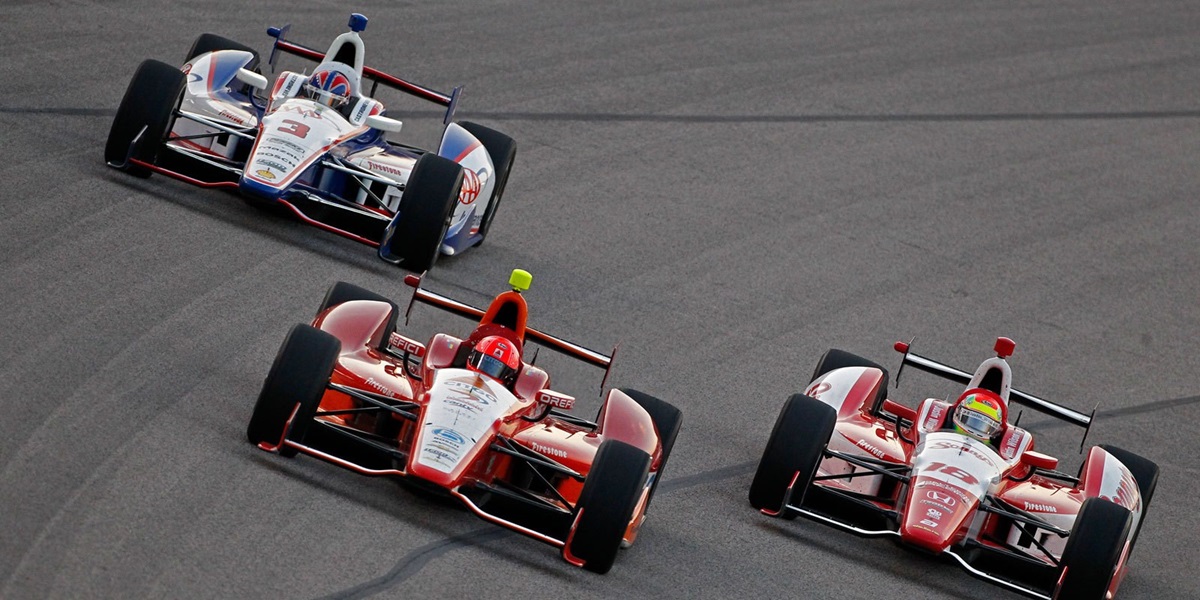
Oreo Reflects on Texas
June 11, 2012 | By John Oreovicz
FORT WORTH – You can look, but you won’t find detailed coverage of the Firestone Firehawk 550 that was written by me.
As always at Texas Motor Speedway, Texas native Terry Blount was on hand for ESPN.com. The bosses were therefore kind enough to give me the weekend off.
So what did I do? I loaded my 5-year old son and myself in the car and headed for…Texas Motor Speedway. I was interested in experiencing an IZOD IndyCar Series race from a fan’s perspective for the first time in more than 20 years, and if I am honest, I wanted to be on hand in case anything notable happened, for better or worse.
I’m delighted to say that Saturday night’s race bore little resemblance to the ‘pack’ racing that the IndyCar Series had become famous for at Texas. I can vividly remember the first IRL-sanctioned race at TMS in 1997, and while most people focus on the post-race contretemps involving A.J. Foyt and race winner Arie Luyendyk, I was flat-out terrified to see so many open-wheel cars running that close at 210-220 mph.
A lot of effort went into making the racing as safe as possible, but I always believed that the combination of the last generation of IndyCar Series chassis and high-banked, 1.5-mile ovals like Texas was extremely dangerous. The extreme banking (24 degrees in the case of Texas, compared with 9 degrees at Indianapolis Motor Speedway) permitted the drivers – all of them – to circulate at 100 percent throttle at all times.
That’s not to say it wasn’t challenging to drive a race car around the track at 215 mph, whether alone or in a pack of cars. But it was nothing compared to Saturday night, when the high-speed oval aerodynamic package unveiled on the Dallara DW12 chassis truly did require the drivers to DRIVE their cars.
You could see over the course of a 40-lap stint – especially late in the race – that the cars were a handful. The vast majority of the drivers asked for a major reduction in downforce for 2012 for that very reason. Instead of being glued to the track, the DW12 slid around and forced the drivers to learn and adapt.
Maybe not surprisingly Justin Wilson, a driver as analytical as the best of them, emerged as the winner, after pressuring Graham Rahal into a mistake with just a couple laps to go.
Rahal hadn’t managed his Firestone tires as well as Wilson over the final stint and he paid the price by whacking the Turn 4 wall with his right rear wheel. He managed to continue and finished second, but the error was a tough psychological blow for the 23-year old son of three-time Indy car champion Bobby Rahal.
Were the cars difficult to drive? Ask defending series champion (and Texas race winner) Dario Franchitti, who dropped through the field like a stone with a loose car on the way to finishing 14th, three laps down to Wilson.
Ask his Target Ganassi Racing teammate Scott Dixon, who dominated the first three-quarters of the race before crashing, on his own, on the 174th lap.
The best news is that, with the exception of Ed Carpenter, who complained about the quality and the style of the racing via Twitter during the event, the drivers were unanimous in their approval of the changes made to the cars for tracks like Texas.
Yes, the cars were more spread out, but there was more passing than you might have seen on TV. Carpenter, for example, started 19th, but made a lot of ground on the track and ran as high as second before ultimately finishing 12th.
Wilson started 17th but really began making his move at about the 100-lap mark. From lap 95-109, he went from seventh place to second, all via passes on the track. But he never took the lead until the 227th circuit of 228.
Along with Franchitti and Tony Kanaan, Wilson was a leader among the drivers in pushing for changes to the cars to make for safer racing on high-speed ovals. They got what they were hoping for Saturday night.
“I think IndyCar did a fantastic job,” Wilson said. “We came here with a great package, and it allowed for people to come and go throughout the race. We weren’t just glued to the racetrack and flat out waiting for something to happen. You’re actually racing each other.
“It’s the most fun I’ve had on an oval,” he added. “Obviously I won, so I’m going to feel a bit biased towards it. But I think it was a great package. I think it was as safe as motor racing goes, but still high stakes. You can’t afford to make a mistake out there.”
I won’t be able to tell you how it looked on TV until I get home and watch the recorded broadcast, but the last gasp action had the TMS crowd on their feet. There was some griping in the grandstands that the racing wasn’t as close as it used to be in Texas Indy car races. But anyone who stuck around for the final 50 laps – when the racing began in earnest – was certainly not disappointed.
From a fan perspective, Texas Motor Speedway is a great place to watch a race, with excellent amenities, comfortable seats and spectacular sight lines of the whole track.
And I’m happy to say that Indy car drivers can now join race fans in truly enjoying the TMS experience.